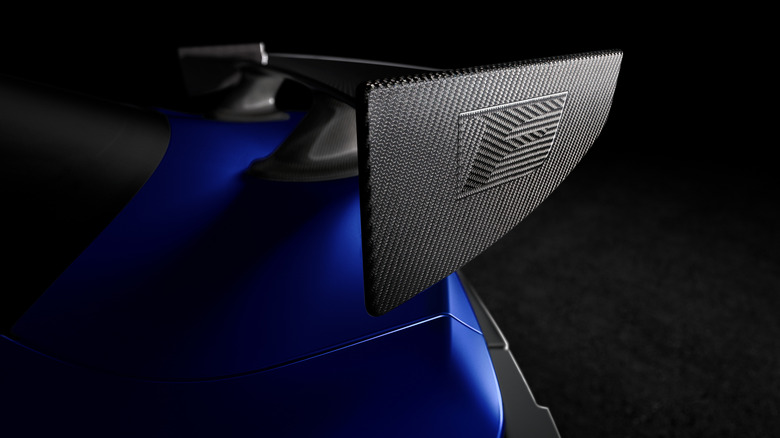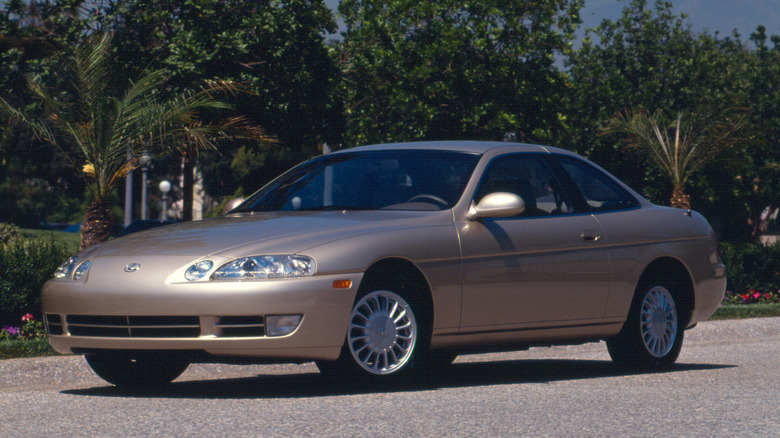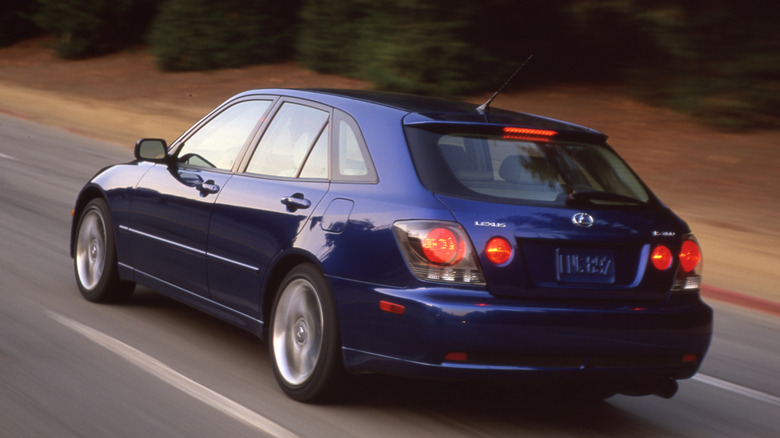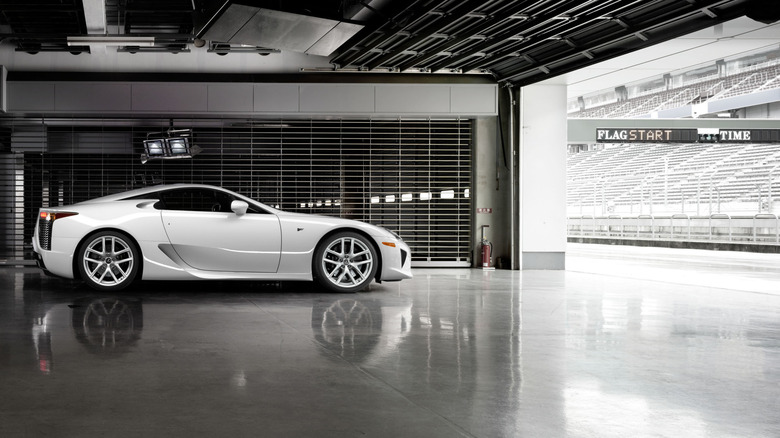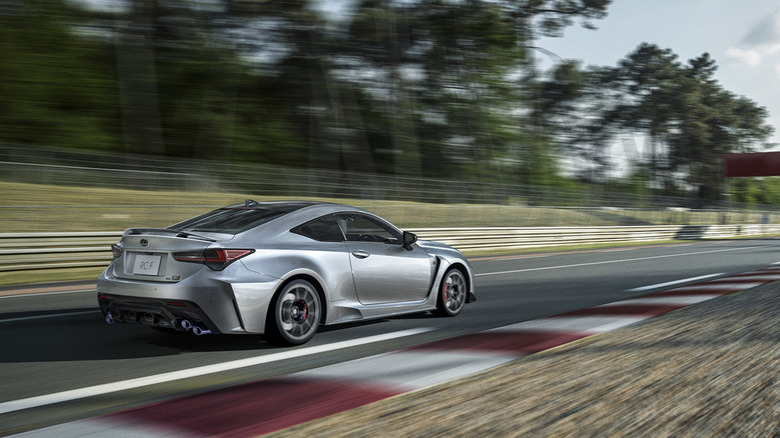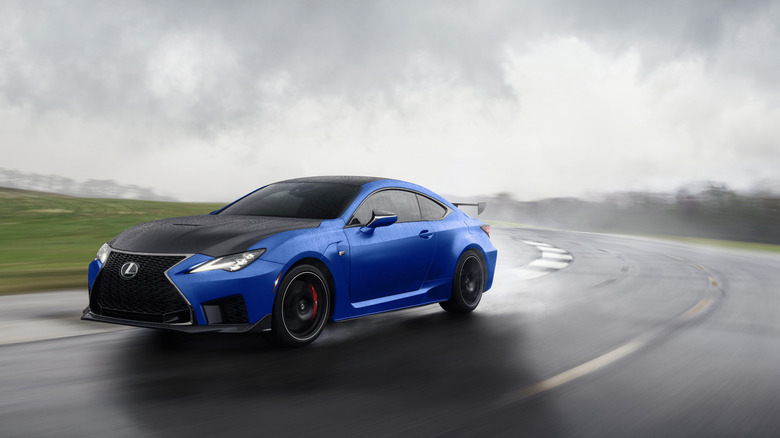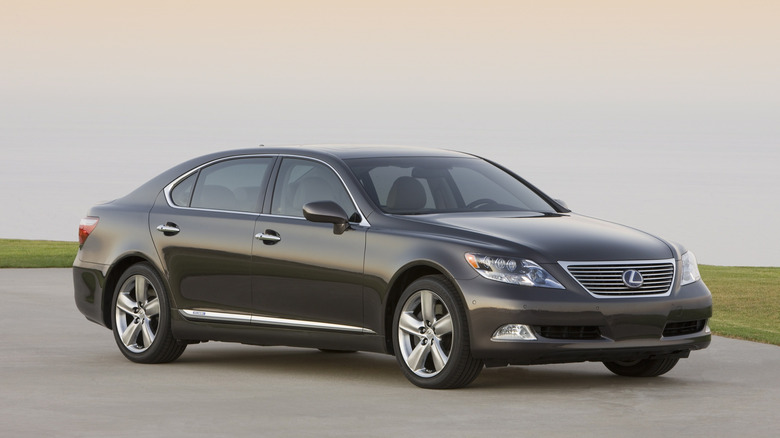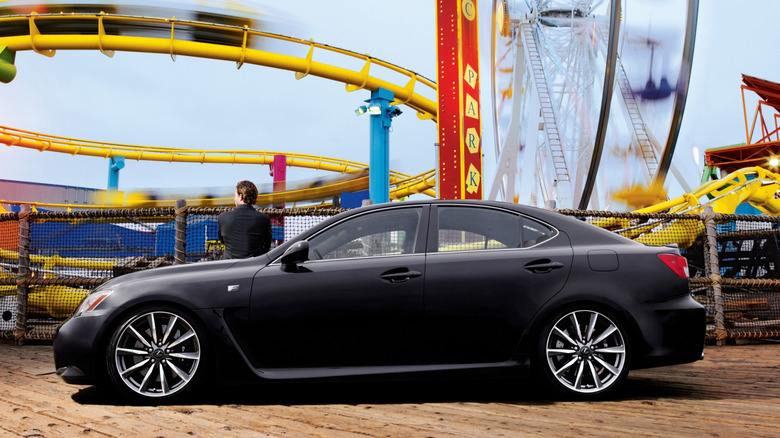8 Of The Rarest Lexus Models In The USA
Ever since it arrived on the scene in 1989, Lexus has been attracting buyers with a unique set of characteristics. Luxurious, well-made, and most importantly, reliable, Lexus cars have been a thorn in the side of established competitors like Mercedes-Benz and BMW. In 2007, the Japanese premium automaker even dipped its toes in the performance segment with the introduction of the V8-powered IS-F sports sedan. This, alongside the more aggressive "spindle grille" front fascia introduced the next decade, attracted younger buyers to the brand.
Today, Lexus is an established luxury automaker with many successful models. The brand regularly appears in the top three spots of the best-selling luxury automakers in the U.S., and has a rich model portfolio that includes everything from sedans to off-road focused SUVs. With all that said, you'd never have thought that Lexus also produced rare cars. Sure, the LFA is a rarity, but other Lexus models? Not so much.
Still, in this piece, you'll discover that reality tells a different story. Some Lexus models weren't quite successful, for example. Moreover, the company produced some super-limited editions for the U.S. market, which you'll probably never see in real life. So, from sales flops to exclusive collector's editions, here are 8 of the rarest Lexus models sold in the United States. Enjoy!
Lexus HS 250h (2009-2012)
You'd be excused not remembering the Lexus HS 250h? It was on the market less than three years and never sold well. In 2010, the first full year of sales, only 10,663 units were sold. But when Lexus launched this tepid-looking sedan in 2009, it marketed it as the "world's first hybrid-only luxury vehicle." Riding on the Prius popularity wave, Toyota's premium brand of course wanted to cash in with a more luxurious version of its hybrid car, thinking that buyers would come running to Lexus dealerships.
And it's not like the HS was a rebadged Prius. It was actually based on the Toyota Avensis, a mid-size counterpart to the Camry sold in Europe. The HS also had a larger 2.4-liter engine, instead of the 1.8-liter in the Prius, and a different hybrid system. As a result, it made 187 hp, enough for a 0-60 time of 8.4 seconds. Not bad when you consider it was also good for 35-mpg combined on regular fuel. Even the suspension was different, with the HS 250h boasting a double wishbone at the rear instead of Prius' torsion beam.
Of course, the HS 250h was way more luxurious inside, though the design was dull. In fact, this dullness permeates everywhere you look, with the exterior being particularly monotonous. Not that Lexus' vehicles were very attractive at that time, but the HS 250h is an exercise in boringness, whether you drive it or not.
Lexus SC 300 Manual (1992-2001)
The first-gen Lexus LS 400 shocked the automotive world when it launched in 1990. Built better, faster, and more luxurious than the Germans, it was a breath of fresh air in the industry. But Lexus was working on another halo model aiming to make an even bigger splash. The SC was the coupe alternative of the LS, and it launched a year after its bigger brother.
Imagined as a luxurious grand tourer, the SC looked sleek and sporty, while retaining the elegance of early Lexus models. Even so, it shared the platform with the MKIV Supra, one of the coolest JDM cars ever built. Still, being a Lexus, the SC needed a V8, so it borrowed the 4.0-liter unit from the LS 400, producing 250 hp and 260 lb-ft of torque. Unfortunately, it also borrowed the four-speed automatic, killing its sporty pretensions.
Curiously, there was an optional manual transmission, but only with the entry-level 3.0-liter inline-six SC 300. The Supra-derived 2JZ-GE naturally aspirated unit made 225 hp and 210 lb-ft of torque; provided you shifted the five-speed manual quickly, it propelled the SC 300 to 60 mph in 7.4 seconds and to a 146-mph top speed.
You would think that most buyers opted for the 3.0-liter manual, but it was actually the rarest specification. Most cars were manual then, and an automatic was seen as a more upmarket option, fitting to a luxury grand tourer. So, somewhat predictably, manual SC 300s command higher prices today.
Lexus IS 300 SportCross (2001-2005)
Sometimes, automakers build incredibly cool vehicles that simply don't resonate with buyers. Maybe its shooting-brake styling just triggers nostalgia in us, or maybe we are just misunderstood enthusiasts attracted by more unique and rare body styles. Even so, although the first-gen Lexus IS was already a head-turner, the Lexus IS 300 SportCross took the sleek design to a whole new level.
The SportCross is also more practical. It has a larger rear opening. Its rear seats fold flat, and even the passenger seat can fold down to carry longer items. These features are a no-brainer today, but the sedan didn't have them. And who doesn't want a practical, yet attractive sports wagon?
The car was powered by the same 2JZ-GE inline-six engine as the SC 300. Here, it made 215 hp and was exclusively paired to a five-speed automatic, which is a bummer. However, that was still enough for a 0-60 time of 7.7 seconds and a limited top speed of 140 mph. That's only slightly slower than the sedan, because the SportCross weighed a meagre 125 pounds more.
You could probably cut a few tenths with a six-speed manual conversion kit, which will also add a bigger smile on your face. The problem is not the manual conversion, though — it's finding an IS 300 SportCross to begin with. Lexus sold fewer than 4,000 of these vehicles, making it a rare sight on roads today.
Lexus LFA (2010-2012)
Lexus already showed it could compete with BMW and Mercedes-Benz with the LS. But to make a statement, it needed a model that would outdo Ferraris and Lamborghinis. A car that young people would proudly put on their walls. So, by the turn of the millennium, Lexus started working on the LFA.
Developed under chief engineer Haruhiko Tanashi, the first Lexus supercar had to stand out. The team decided on a high-strung V10 engine, lightweight aluminum construction, and set sights at a 200-plus mph top speed. In 2007, they switched the whole car to carbon fiber, saving over 220 pounds of body weight (3,559 pounds), but also added two more years to the development.
The resulting Lexus LFA turned out to be a no-compromise supercar for the ages. Lexus engineered every detail to perfection. Developed on the racetrack, it never complained being driven at 100%, day-in, day-out. Its body was designed for high downforce and low drag, but it still looked elegant. Basically, the LFA combined form and function perfectly. And that's before we start talking about the engine.
Co-developed with Yamaha, the LFA's naturally aspirated 4.8-liter V10 is pretty special. 553 hp at 8,700 rpm. 354 lb-ft of torque at 6,800 rpm. 9,000-rpm redline. An acoustic spectacle that no other engine could match. Unfortunately, most Americans can only ever hear it online, as Lexus allocated only 190 units (of 500) for the U.S. market.
Lexus RC F Final Edition (2025)
Lexus is slowly killing off its V8-powered cars. The latest model to get the axe is the RC F, which has been discontinued (along with the regular RC coupe) with no replacement in sight. However, the RC F is going out with a bang. As expected, the fittingly titled RC F Final Edition brings a few performance upgrades to the regular performance coupe.
However, while the rarity of this model will probably be the big draw for buyers — Lexus is building only 185 units — that's not to say this $94,000 car doesn't stand on its own merit. Under the aggressive hood hides a 5.0-liter V8 that produces 472 hp and 395 lb-ft of torque, paired to an eight-speed automatic. Thankfully, it's a naturally aspirated unit that sounds quite lovely at higher rpm, with responsiveness that turbocharged engines can't match. However, you should be really into that V8 noise, because with a 0-60 time of 4.2 seconds, the RC F Final Edition is slower than the BMW M4, which gets there in just 3.4 seconds.
Thus, Lexus tried to sweeten the deal with a few performance upgrades. The Final Edition gets GT3-inspired looks, forged 19-inch BBS wheels with specially developed Michelin Pilot Sport 4S tires, and monoblock six-piston front and four-piston rear Brembo brakes. There is even some weight reduction thanks to the carbon fiber roof, lower front spoiler, rocker-panel splitters and rear diffuser. The carbon fiber theme continues inside, accompanied by performance seats trimmed in Circuit Red and Black leather.
Lexus RC F Fuji Speedway Edition (2021)
The RC F Final Edition is an attractive model for Lexus enthusiasts who want a unique vehicle in their driveway. Still, Lexus' performance coupe was available in other, even rarer and decidedly more aggressive versions. Undeniably the best RC F that has ever reached showrooms is the Fuji Speedway Edition. This model was specifically developed to pay homage to the Toyota-owned Fuji Speedway circuit, making it a true unicorn in the lineup. Oh, and Lexus built just 50 units.
Unfortunately, Lexus engineers deemed an engine tune unnecessary to slice lap times. The RC F has the same 472-hp 5.0-liter V8 and eight-speed automatic as the regular RC F. However, the Fuji Speedway Edition accelerates to 60 in much quicker 3.96 seconds. As you might've guessed, it's all thanks to a significant weight reduction of 178 pounds. The Fuji Speedway Edition features carbon fiber roof, hood, lip and air dam front spoiler, fin rocker, door lower molding, and retractable wing rear spoiler.
Still, the RC F Fuji also has a lighter titanium exhaust, forged 19-inch BBS wheels and Brembo carbon ceramic brakes to improve braking performance. Furthermore, the more aggressive aero keeps the coupe glued to the asphalt at higher speeds, while the F-tuned Adaptive Variable Suspension means the driver can choose between comfort and agile handling. The RC F Fuji Speedway Edition was only available in the blue "Electric Surge" exterior color.
Lexus LS 600h Pebble Beach Edition (2009)
Lexus introduced the fourth generation of its flagship car in 2006. With a new L-finesse design that looked more dynamic than the dull predecessor, and brand-new engines, the LS was ready to once again compete with the Germans. For the first time, Lexus also launched a hybrid version of the LS; called the LS 600h L (for long wheelbase), it packed a 5.0-liter V8, assisted by two electric motors for a total output of 438 hp. 0-60: a brisk 5.5 seconds. More importantly, the powertrain was whisperingly quiet, in line with the luxury credentials.
As such, the LS 600h L was the perfect candidate for the ultimate Pebble Beach Edition. Limited to just 50 examples, this high-end model refined the LS design with Truffle Mica exterior color and special five-spoke 19-inch wheels. Inside, this rarity had a two-tone Alabaster and Black leather trim, accompanied by slick-looking Dark Grey Bird's-eye maple wood inserts, Pebble Beach badging, blue illuminated scuff plates, and premium black floor mats. The Pebble Beach Edition also came standard with a rear-seat entertainment system, which included screens for the rear passengers and power-rear sunshades.
But the most game-changing development was the addition of the Advanced Pre-Collision System (APCS). This was the world's first safety system to detect pedestrians using two cameras and a millimeter-wave radar system. Today, most vehicles are equipped with a similar system, but now you know that it pioneered in a limited-edition Lexus LS.
Lexus IS-F Neiman Marcus (2007)
Automakers collaborating with clothing brands for limited edition models is nothing new. Porsche collaborated with Aimé Leon Dore to produce stunning restored 911 classics, while Kith was tasked with dressing the BMW XM. Lexus' clothing company of choice was Neiman Marcus, which had interestingly already worked with various automakers on special-edition vehicles like the 1998 Aston Martin DB7 Volante and 1970 Ford Thunderbird.
The Lexus IS-F Neiman Marcus special edition was the automaker's first true performance car, after all, packing a sonorous 5.0-liter V8 under the bonnet, accompanied by an eight-speed automatic transmission. With 416 hp on tap and a Fuji racetrack tuned chassis, the Lexus IS-F impressed colleague Chris Davies in our 2014 review. Hardly surprising, as the IS-F is quick even by today's standards, with 60 mph arriving in 4.5 seconds. It's capable in the corners, too, thanks in no small part to the Vehicle Dynamics Integrated Management (VDIM).
The Neiman Marcus edition did little to enhance the driving experience; in fact, the only way this model improved performance was by teaching the driver to drive faster, with each of the 50 owners receiving half-day of pro-driver training on track. Of course, these Lexus-selected owners also enjoyed a more sophisticated interior. The IS-F Neiman Marcus had black seats with a white accent stitching and white leather inserts on the steering wheel. On the exterior, Neiman Marcus opted for hand-polished wheels to contrast the black Obsidian paint job.
